
Just a few years before I moved to Oklahoma at age 3, this is what my town looked like.
(Excerpted from my upcoming book, Tinkertown: What a City and an Air Base Meant to Us.)
A town can inspire and fuel dreams, usually without us realizing it until much later.
This story chronicles the blended history of two unique places in Oklahoma, each made distinct because they both came into existence at the same time, not all that long ago, right across the street from each other, in the shadow of the state’s capital city.
Together, Tinker Air Force Base, which began life as the Midwest Air Depot, and the similarly named Midwest City have influenced each other physically, socially, and culturally since their founders’ first shovels went into the ground as the decade of the 1940s began.
A key base, a pop-up town
Today, Tinker is the largest Air Force maintenance installation for aircraft in the world and is also the largest single-site employer for Oklahoma producing an economic imprint of $3.51 billion.
As for Midwest City, it arose from cropland in 1942 to become the eighth largest city in the state with a population of more than 65,000 at its height.
The human element
But there is also a human side – a memoir element — to this history. My family, friends, and I grew up in Midwest City even as this small town and Tinker were growing up. We bore witness to the times, the people, places, and events – some good, some tragic – that became our history.
More importantly, we witnessed and became part of the culture that grew out of this marriage of an Air Force base and a town. And, as each of these influenced the other, the people of Midwest City and Tinker influenced both.
I’m sure the same kind of dynamics have been experienced by other military towns and their bases. Yet the dynamics here bear striking differences. For one thing, most of the employees at Tinker are not military, but civilians who work for the government in civil service jobs and as civilian contractors.
That has always made this Air Force base seem just as much like a civilian industrial plant as a military base.
Midwest City began as a working-class community of people who got their first real job there after the state’s infamous Dust Bowl era. A large portion of its population still fits that blue-collar demographic, although many who were educated in Midwest City’s excellent school system have advanced into stellar professional careers.
What rubbed off?
Throughout the story, I’ve been asking myself the question, “How much of me comes from my hometown and why?” Looked at another way, “Is where I’m from, who I am?” I would suggest readers ask themselves the same question, because the answer may be surprising, as it was for me.
Examples of the Tinkertown symbiosis abound, and it’s why I give the story this name. The most obvious example is how Midwest City – a blueprinted and planned community before the first house was ever built – was created to serve the needs of the workers at Tinker field.
An enterprising founder
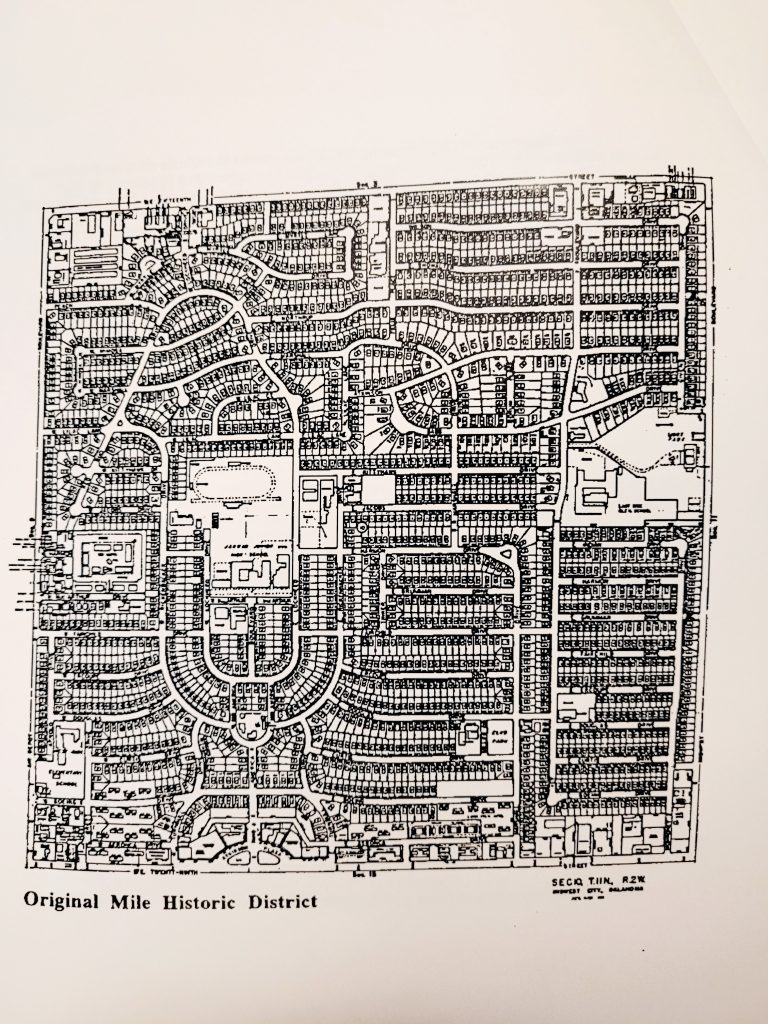
The “original mile” of Midwest City, built mostly in the first four years from 1942-46. Tinker AFB sprawls along the southern border of 29th Street.
It is noteworthy that the urban designer who developed the plan patterned it after the plan of Washington D.C. Midwest City’s founder, W.P. “Bill” Atkinson, was introduced to this planner by Pentagon officials, and Atkinson made good on his promise to develop such a full-service town.
It was Atkinson who managed to purchase the first 320 acres of farmland across 29th Street from the planned base after using his journalistic training to find out where Tinker would be located.
Since I was one of the young witnesses to the first two decades of Tinker and Midwest City, much of this story of Tinkertown is told through my eyes, my memories and experiences, and those of my friends who were part of the fabric of the story.
My Ohio prelude
Although I like to think I began life as an Oklahoma Sooner, such was not the case. I drew my first breath in the Buckeye state of Ohio, in its capital city of Columbus.
The year was 1946, the month was March, and the War in the Pacific had been over six months and fourteen days. The dropping of the two atomic bombs on Japan had brought the entirety of World War II to an end. Of course, I knew nothing of this on that March 19 morning when I first opened my eyes to this earthly life.
The trains to dreams
I have one indelible memory of my three years in Columbus. The most vivid one – probably because it was a regular occurrence – was watching the big trains out back that would chug past our apartment complex several times every day.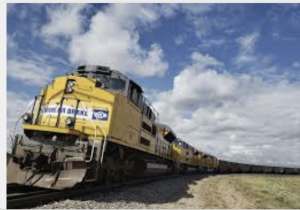
I began wishing I could be traveling with these passengers to new and far-off places.
My big sister C.J. and I would sit out back of our apartment and stare up the grade as each train would approach, pass by, and then head off to their destinations.
We’d wave at the engineer who was at the throttle of the beast’s engine, and he would often be wearing one of those striped railroad caps from bygone days. A cigarette might be dangling from his lips that would break into a broad smile as he saw us kids.
Sometimes, he would reach above him and a yank on the whistle cord. The train was saying hello as we waved good-bye.
To me, this was the most impressive part of the large Ohio railroad industry: just watching these massive train engines and cars roll past our apartment with such regularity.
So, while other kids might listen to The Green Hornet on radio or go to the movies with their parents for entertainment, C.J. and I spent more of our free time out back watching the trains take people and goods on down the track.
Wanderlust is born
It’s not a stretch to think that this experience is where wanderlust first entered my soul. In a very short time, however, I would be adding a lust for airplane travel onto my passion for moving trains. That would happen when my family moved to a town in Oklahoma right across the street from a huge Air Force base named Tinker Field.
In whatever form of transport, I fell in love with the idea of going to new and exciting places (the adjectives meant the same thing to me). This wanderlust would be my companion and motivator for the rest of my life as I traversed the country and the globe.
Lifelong imagineer
The imagineering I did as a young child, wondering what adventures these train and plane passengers were taking, would be the same kind of wonderment I would have as an adult as I imagined what it would be like to live over the next hill, or the ones beyond that.
And, many times, I would just pack up and go see for myself. Later in life I remember seeing the Steve Martin/John Candy film, Planes, Trains, and Automobiles, and thinking how much of my life has been spent happily traveling in all three.
I could even add boats to that list because, perhaps ironically for a guy who grew up in an Air Force town, I chose the Navy in college and spent some time on a destroyer in the Pacific as a midshipman.
Moving to Oklahoma
Beyond these memories, the rest of my toddler Columbus experience is forever hidden from my view. I don’t even have a memory of our move from Ohio to Oklahoma, which we did in 1949 when my dad got a job in advertising at an Oklahoma City television station.
Dad had been out of the Navy for a couple years and had moved to Columbus to do promotional artwork for a savings and loan there. He had always had a talent for sketching, and it served him well as he transitioned into ad design and later, in ad sales and management.
Dad was part of a new breed of Madmen, albeit in Oklahoma City and not New York. In fact, he would become president of the Oklahoma Ad Club. He had a brother in Oklahoma, and I always assumed that was part of the reason we moved there.
Inspirations led to passions
It served me well, because my wordsmith dad became my first editor in life, reading over the adventure stories I would scribble out after developing a strong interest in reading and writing from the public library a few doors down from our home.
The placement of that library between me and the grade school I walked to and from everyday proved important to me and my literary career. And the quality of schools we had (enhanced by federal money because of Tinker) inspired me to learn.
So the Willis tribe left Columbus and headed to Oklahoma and this new suburb of Midwest City. It was fine with C.J. and me, although Oklahoma would become a reluctantly acquired taste for my mother who had known some finer things in life in her native Pennsylvania.
Some dust remained
Oklahoma, on the other hand, was only a decade removed from the Dust Bowl days, and from John Steinbeck’s classic book about it, The Grapes of Wrath. The film version of it, starring Henry Fonda, had premiered in 1940. Most of the nation still identified Oklahoma with poverty and saw it as the state that people were leaving; not flocking to. In fact, before all the streets were paved, Midwest City was often dubbed “Mudwest City.”
A town fit for a boy
One thing would prove true, however: our Oklahoma home in this new town called Midwest City, alongside this big Air Force base called Tinker, would be an adventure worthy of a young boy who was already captivated by the novelties of life.
These were the passions programmed for me by my two hometowns: travel, education, and writing. They would be the keys I used to open those doors of adventure and to revel in those experiences.
I am a writer, college professor, and author of several nonfiction books, including three on the decade of the 1960s. Several wonderful essays of gifted Retrospect authors appear in my book, "Daily Life in the 1960s."


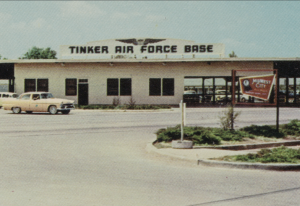
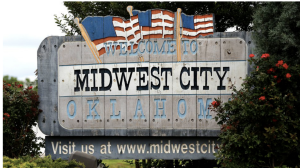
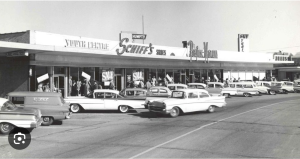

Fascinating to learn how that big train in Columbus inspired wanderlust in you, Jim. And your move to Midwest City (which somehow sounds like something out of a Wes Anderson movie) further shaped your love of adventure, words and writing. We in the Retro community are the beneficiaries of those interests.
Thank you, Betsy! It’s still a fun ride.
Wonderful story wonderfully written Jim, and thanx for the preview of your upcoming book.
You made me feel I was sitting out back with you and CJ watching the trains – a long stretch for this Bronx kid who through “train” meant the New York subway! And it happens March 19 is my son’s birthday too so now I’ll never forget yours!
Let us know when your book is published!
Thanks, Dana. It was fun writing it! Happy holidays!
I had never heard of Tinker Air Base or Midwest City before reading this–and yet it was, and is, a thriving piece of Oklahoma. And trains–so overlooked since the interstates came in–represented so much in myth and reality. You expand horizons and bring back those times with a personal touch.
I don’t think anyone outside Oklahoma has heard of Midwest City, Khati. Maybe my book will change that!
A very moving and interesting story, Jim! My hometown fell on some hard times when the local military base* was shut down; glad that Tinker, and your town, were spared that fate.
*https://en.wikipedia.org/wiki/Military_Ocean_Terminal_at_Bayonne
Thanks, Dave. Yes, my town was very fortunate!